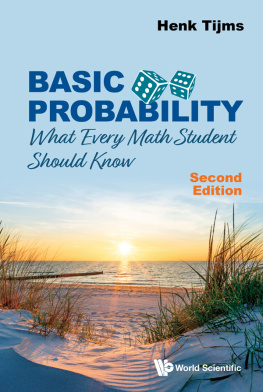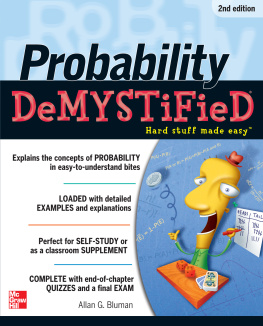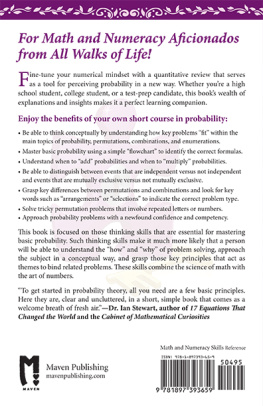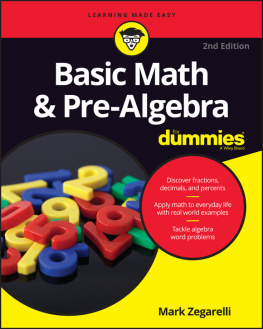Henk Tijms - Basic probability: What Every Math Student Should Know (2nd Edition)
Here you can read online Henk Tijms - Basic probability: What Every Math Student Should Know (2nd Edition) full text of the book (entire story) in english for free. Download pdf and epub, get meaning, cover and reviews about this ebook. year: 2021, publisher: World Scientific Publishing Co. Pte. Ltd., genre: Children. Description of the work, (preface) as well as reviews are available. Best literature library LitArk.com created for fans of good reading and offers a wide selection of genres:
Romance novel
Science fiction
Adventure
Detective
Science
History
Home and family
Prose
Art
Politics
Computer
Non-fiction
Religion
Business
Children
Humor
Choose a favorite category and find really read worthwhile books. Enjoy immersion in the world of imagination, feel the emotions of the characters or learn something new for yourself, make an fascinating discovery.
- Book:Basic probability: What Every Math Student Should Know (2nd Edition)
- Author:
- Publisher:World Scientific Publishing Co. Pte. Ltd.
- Genre:
- Year:2021
- Rating:3 / 5
- Favourites:Add to favourites
- Your mark:
- 60
- 1
- 2
- 3
- 4
- 5
Basic probability: What Every Math Student Should Know (2nd Edition): summary, description and annotation
We offer to read an annotation, description, summary or preface (depends on what the author of the book "Basic probability: What Every Math Student Should Know (2nd Edition)" wrote himself). If you haven't found the necessary information about the book — write in the comments, we will try to find it.
Henk Tijms: author's other books
Who wrote Basic probability: What Every Math Student Should Know (2nd Edition)? Find out the surname, the name of the author of the book and a list of all author's works by series.
Basic probability: What Every Math Student Should Know (2nd Edition) — read online for free the complete book (whole text) full work
Below is the text of the book, divided by pages. System saving the place of the last page read, allows you to conveniently read the book "Basic probability: What Every Math Student Should Know (2nd Edition)" online for free, without having to search again every time where you left off. Put a bookmark, and you can go to the page where you finished reading at any time.
Font size:
Interval:
Bookmark:



Published by
World Scientific Publishing Co. Pte. Ltd.
5 Toh Tuck Link, Singapore 596224
USA office: 27 Warren Street, Suite 401-402, Hackensack, NJ 07601
UK office: 57 Shelton Street, Covent Garden, London WC2H 9HE
Library of Congress Cataloging-in-Publication Data
Names: Tijms, H. C., author.
Title: Basic probability : what every math student should know / Henk Tijms.
Description: Second edition. | New Jersey : World Scientific, [2021] | Includes index.
Identifiers: LCCN 2021012561 | ISBN 9789811237492 (hardcover) | ISBN 9789811238512 (paperback) | ISBN 9789811237508 (ebook)
Subjects: LCSH: Probabilities--Textbooks.
Classification: LCC QA273.2 .T54 2021 | DDC 519.2--dc23
LC record available at https://lccn.loc.gov/2021012561
British Library Cataloguing-in-Publication Data
A catalogue record for this book is available from the British Library.
Copyright 2021 by World Scientific Publishing Co. Pte. Ltd.
All rights reserved. This book, or parts thereof, may not be reproduced in any form or by any means, electronic or mechanical, including photocopying, recording or any information storage and retrieval system now known or to be invented, without written permission from the publisher.
For photocopying of material in this volume, please pay a copying fee through the Copyright Clearance Center, Inc., 222 Rosewood Drive, Danvers, MA 01923, USA. In this case permission to photocopy is not required from the publisher.
For any available supplementary material, please visit
https://www.worldscientific.com/worldscibooks/10.1142/12295#t=suppl
Printed in Singapore
Preface
Probability is a fascinating branch of mathematics and indispensable for statistical literacy. In modern society it is necessary to be able to analyze probability claims in the media and to make informed judgments and decisions. This book provides a basic introduction to probabilistic thinking and reasoning under uncertainty, and illustrates it with many instructive and interesting examples.
All the essential aspects of basic probability are covered in this book. It grew out of a probability book I wrote for Dutch high school students and it is written for students learning about probability for the first time. The book is aimed specifically at statistics and data science students who need an accessible and solid introduction to the basics of probability. Probability is the bedrock for statistics and data science.
Key features of the book are conditional and Bayesian probability, real-world applications of the Poisson distribution, and the interplay between probability and computer simulation. Computer simulation is not only a computational tool for solving probability problems, but it is also a useful didactic tool for helping students to gain a better understanding of probabilistic ideas. The emphasis of the book is on discrete probability, but continuous probability distributions are also treated. Scattered throughout the text, many remarks are made on the history of probability.
Because probability is a difficult subject for the beginner, the approach followed in this book is to develop probabilistic intuition before getting into details. Whereas many probability problems are easy to understand, the solutions can require clever and creative thinking. The best way to learn probability is by doing a lot of problems. Many instructive problems together with problem-solving strategies are given. Answers to all problems and worked-out solutions to selected problems are provided to increase students confidence in problem solving and to stimulate students active learning.
Preface to the Second Edition
In the second edition many didactic improvements have been made. Also, many extra motivational examples and problems have been added. The material on Bayesian probability has been expanded by two famous court cases. The chapter on real-life applications of the Poisson distribution has been expanded by two new sections. Sections on generating functions and the bivariate normal distribution have been added. The roles of the law of large numbers and the central limit theorem in computer simulation have been discussed in more depth. The most significant change is the addition of an introductory chapter on Markov chains, including absorbing Markov chains and Markov chain Monte Carlo simulation. This appealing material, which is popular with students, can be addressed directly after the notion of conditional probability has been discussed.
Finally, thanks to all those who have made valuable comments on the first edition. In particular, I would like to thank Karl Sigman and Alan Vraspir.
Chapter 1
Combinatorics and Calculus for Probability
This chapter presents a number of results from combinatorics and calculus, in preparation for the subsequent chapters. the exponential function and the natural logarithm will be discussed.
1.1 Factorials and binomial coefficients
Many probability problems require counting techniques. In particular, these techniques are extremely useful for computing probabilities in a chance experiment in which all possible outcomes are equally likely. In such experiments, one needs effective methods to count the number of outcomes in any specific event. In counting problems, it is important to know whether the order in which the elements are counted is relevant or not. Factorials and binomial coefficients will be discussed and illustrated.
In the discussion below, the fundamental principle of counting is frequently used: if there are a ways to do one activity and b ways to do another activity, then there are ab ways of doing both. As an example, suppose that you go to a restaurant to get some breakfast. The menu says pancakes, waffles, or fried eggs, while for a drink you can choose between juice, coffee, tea, and hot chocolate. Then the total number of different choices of food and drink is 3 4 = 12. As another example, how many different license plates are possible when the license plate displays a nonzero digit, followed by three letters, followed by three digits? The answer is 9 26 26 26 10 10 10 = 158 184 000 license plates.
Factorials and permutations
How many different ways can you order a number of different objects such as letters or numbers? For example, what is the number of different ways that the three letters A, B, and C can be ordered? By writing out all the possibilities ABC, ACB, BAC, BCA, CAB, and CBA, you can see that the total number is 6. This brute-force method of writing down all the possibilities and counting them is naturally not practical when the number of possibilities gets large, as is the case for the number of possible orderings of the 26 letters of the alphabet. You can also determine that the three letters A, B, and C can be ordered in 6 different ways by reasoning as follows. For the first position, there are 3 available letters to choose from, for the second position there are 2 letters left over to choose from, and only one letter for the third position. Therefore the total number of possibilities is 3 2 1 = 6. The general rule should now be evident. Suppose that you have
Font size:
Interval:
Bookmark:
Similar books «Basic probability: What Every Math Student Should Know (2nd Edition)»
Look at similar books to Basic probability: What Every Math Student Should Know (2nd Edition). We have selected literature similar in name and meaning in the hope of providing readers with more options to find new, interesting, not yet read works.
Discussion, reviews of the book Basic probability: What Every Math Student Should Know (2nd Edition) and just readers' own opinions. Leave your comments, write what you think about the work, its meaning or the main characters. Specify what exactly you liked and what you didn't like, and why you think so.







